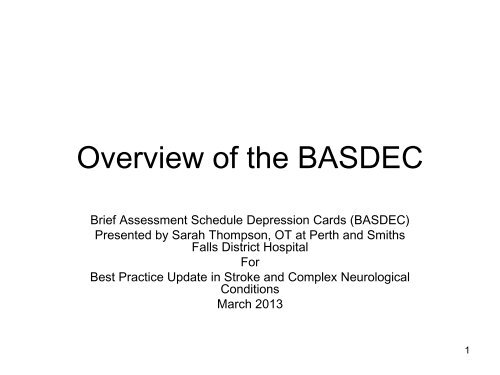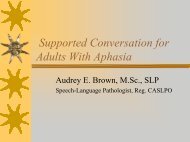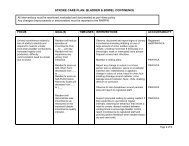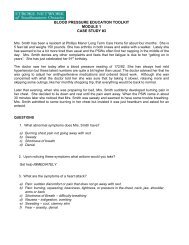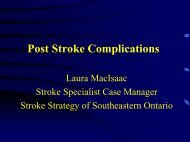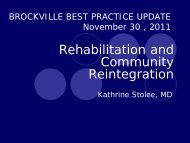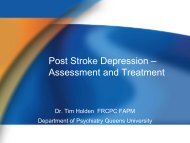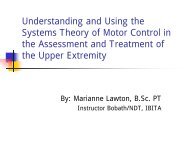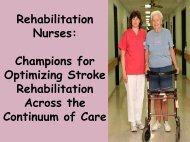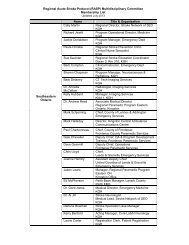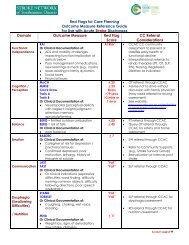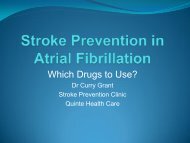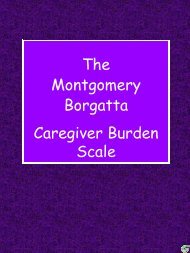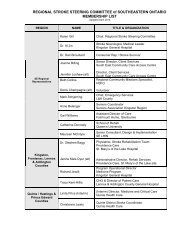Overview of the BASDEC
Overview of the BASDEC
Overview of the BASDEC
Create successful ePaper yourself
Turn your PDF publications into a flip-book with our unique Google optimized e-Paper software.
<strong>Overview</strong> <strong>of</strong> <strong>the</strong> <strong>BASDEC</strong><br />
Brief Assessment Schedule Depression Cards (<strong>BASDEC</strong>)<br />
Presented by Sarah Thompson, OT at Perth and Smiths<br />
Falls District Hospital<br />
For<br />
Best Practice Update in Stroke and Complex Neurological<br />
Conditions<br />
March 2013<br />
1
<strong>BASDEC</strong><br />
• Brief Assessment Schedule Depression<br />
Cards<br />
• Screening tool to help health care<br />
providers identify if a client is at risk <strong>of</strong><br />
depression<br />
• Comprised <strong>of</strong> 19 statement cards and a<br />
“TRUE” and a “FALSE” card<br />
• Takes approximately 2-8 minutes to<br />
administer<br />
2
Picture <strong>of</strong> <strong>BASDEC</strong> cards<br />
3
Example <strong>of</strong> first 3 <strong>BASDEC</strong><br />
statement cards<br />
4
<strong>BASDEC</strong> Administration<br />
• Seek informed consent.<br />
• Quiet, non-distracting environment.<br />
• Place <strong>the</strong> “TRUE” and “FALSE” cards on <strong>the</strong><br />
table in front <strong>of</strong> <strong>the</strong> client and show <strong>the</strong>m to <strong>the</strong><br />
client.<br />
• Hand one card at a time to <strong>the</strong> client.<br />
• Ask <strong>the</strong>m to think about <strong>the</strong> statement on each<br />
card and place it in <strong>the</strong> “TRUE” or “FALSE” pile<br />
depending on <strong>the</strong>ir feelings about each<br />
statement.<br />
5
<strong>BASDEC</strong> Administration<br />
• You may wish to read each statement out<br />
loud to <strong>the</strong> client depending on <strong>the</strong>ir<br />
eyesight/reading ability.<br />
• Try to keep <strong>the</strong> “TRUE” and “FALSE”<br />
cards visible as <strong>the</strong> client places <strong>the</strong><br />
statement cards on top.<br />
• Its OK to make an “I don’t know” pile in <strong>the</strong><br />
middle if needed.<br />
6
Scoring <strong>the</strong> <strong>BASDEC</strong><br />
• Each card in <strong>the</strong> “TRUE” pile is worth one<br />
point, except for “I have seriously<br />
considered suicide” and “I have given up<br />
hope” which are worth 2 points if<br />
answered “TRUE” and 1 point if answered<br />
“I Don’t Know”.<br />
• Cards placed in an “I don’t know” pile earn<br />
half a point.<br />
• Cards in <strong>the</strong> “False” pile are worth zero.<br />
7
Scoring <strong>the</strong> <strong>BASDEC</strong><br />
• Add up all points.<br />
• The cut-<strong>of</strong>f score is 7 points.<br />
• If <strong>the</strong> client scores 6 or less, <strong>the</strong>y are not<br />
considered being at risk for depression at<br />
this time.<br />
• If <strong>the</strong> client scores 7 or higher, <strong>the</strong>y are<br />
considered as being at risk for depression.<br />
8
Benefits <strong>of</strong> administering <strong>the</strong><br />
<strong>BASDEC</strong><br />
• The <strong>BASDEC</strong> has been shown to be reliable and<br />
appropriate for <strong>the</strong> nature <strong>of</strong> stroke.<br />
• You can accommodate for hemispheric neglect<br />
by placing both <strong>the</strong> “TRUE” and “FALSE” piles in<br />
one half <strong>of</strong> <strong>the</strong> client’s visual field.<br />
• The <strong>BASDEC</strong> can be used by any member <strong>of</strong><br />
<strong>the</strong> team who has established a trust<br />
relationship with <strong>the</strong> client.<br />
9
Limitations <strong>of</strong> <strong>the</strong> <strong>BASDEC</strong><br />
• The <strong>BASDEC</strong> is simply a screening tool and is<br />
not intended to be diagnostic.<br />
• Clients with severe perseveration may tend to<br />
place all <strong>the</strong> cards in one pile and you will need<br />
to help <strong>the</strong>m clarify whe<strong>the</strong>r <strong>the</strong>y intended to use<br />
<strong>the</strong> “TRUE” or “FALSE” pile.<br />
• Some clients with significant receptive language<br />
impairments cannot use this verbal/print based<br />
tool and you will need to use a care-giver based<br />
screening tool instead as well as clinical<br />
observation.<br />
10
<strong>BASDEC</strong> follow-up<br />
• Make sure you have given yourself<br />
enough time to provide emotional support<br />
if <strong>the</strong> client has a high score or places a<br />
particularly sensitive statement in <strong>the</strong><br />
“TRUE” pile.<br />
• Know who your “go-to” person is if a client<br />
tells you about suicidal thoughts or plans.<br />
• Make appropriate referral if your client is at<br />
risk <strong>of</strong> depression.<br />
11
Depression in Clients with Stroke<br />
• Depression has been shown to impair ADLs,<br />
cognition, mobility and language which are <strong>the</strong><br />
very things we as health care providers are<br />
trying to help restore independence in.<br />
• Depression following stroke lasts for an average<br />
<strong>of</strong> 9-12 months and can last up to 3 years, so it<br />
spans <strong>the</strong> continuum <strong>of</strong> care in which you work.<br />
• 30-50% <strong>of</strong> stroke survivors experience poststroke<br />
depression.<br />
12
Importance <strong>of</strong> using an Outcome<br />
Measure to Screen for Depression<br />
• Gives weight to your referral<br />
• Can be used to re-screen after a suitable interval <strong>of</strong> time<br />
to see if treatments are working or how <strong>the</strong> client is<br />
coping over time.<br />
• Clarifies which symptoms are stroke symptoms and<br />
which are depression symptoms (impaired attention,<br />
concentration, processing speed, disturbed sleep and<br />
appetite, fatigue and heightened emotionalism).<br />
• Gives clients <strong>the</strong> oportunity to report <strong>the</strong>ir symptoms.<br />
• Opens up <strong>the</strong> oportunity to <strong>of</strong>fer emotional support.<br />
• Helps differentiate between normal reactions to losses<br />
after stroke versus mood pathology.<br />
13
<strong>BASDEC</strong><br />
• Post stroke depression can be treated.<br />
• Treatment <strong>of</strong> post stroke depression leads<br />
to better outcomes for stroke survivors.<br />
• The first step is screening for depression.<br />
• The Stroke Network has ordered<br />
<strong>BASDEC</strong> cards for CCAC <strong>of</strong>fices.<br />
• See www.strokenetworkseo.ca for<br />
information on stroke survivor and<br />
caregiver support groups in your area.<br />
14


